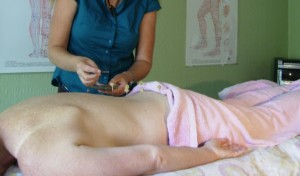Acupuncture: Alternative Pain Relief Method for Fibromyalgia?
 Acupuncture is quickly growing as one of the most accepted and popular alternative therapies used. Today we discuss the different effects of acupuncture and talk about how it is an effective and safe alternative for fibromyalgia pain treatment. Keeping in mind with fibro everyone’s pain is different and so is the treatments. Make sure to consult with your Doctor before starting anything new.
Acupuncture is quickly growing as one of the most accepted and popular alternative therapies used. Today we discuss the different effects of acupuncture and talk about how it is an effective and safe alternative for fibromyalgia pain treatment. Keeping in mind with fibro everyone’s pain is different and so is the treatments. Make sure to consult with your Doctor before starting anything new.
The ancient Chinese alternative pain relief method called Acupuncture has an estimated 15 million Americans trying this unconventional therapy. Many chronic pain clinics are now offering acupuncture and even some insurance covers the cost. The intent of this therapy is to promote health and alleviate pain. Though process of acupuncture may seem strange and mysterious, it has been tested for thousands of years and continues to be validated as an effective treatment today.
The perspective of how an acupuncturist views health and sickness is through the concepts of vital energy, energy balance and energy imbalance. Just as our everyday Physicians monitor the blood flowing through blood vessels and the messages traveling via the nervous system, the acupuncturist assesses the flow and distribution of this vital energy within its pathways, known as meridians and channels.
The World Health Organization endorses acupuncture as an alternative pain relief for more than 40 conditions as diverse as asthma and chronic pain. The Food and Drug Administration regulates acupuncture needles as medical devices, the same as it does surgical tools. And in 1997, a National Institutes of Health panel found acupuncture to be an acceptable treatment for many pain conditions, including fibromyalgia and general musculoskeletal pain.
Modern studies show that acupuncture stimulates one or more of the signaling systems, which under certain circumstances, can increase the rate of healing response. This may be sufficient to cure a disease, or it might only reduce its impact (alleviate some symptoms). These findings can explain most of the clinical effects of acupuncture therapy.
It is also no surprise that some rheumatologists recommend acupuncture to be used alongside more conventional treatments. There are a few patients who even perform the acupuncture treatments on themselves.
When performed by a properly trained and licensed practitioner, acupuncture is safe and effective, free from adverse or addictive side effects. Quite often, a sense of relaxation and well-being occurs during and after treatments. While undergoing therapy for one ailment, other problems may resolve concurrently. This is a common side benefit that again demonstrates the value of balancing the quality and quantity of vital energy within the entire person.
Licensed acupuncturists know the human anatomy well, and insert needles in a safe fashion. The instruments used to penetrate the skin are either pre-sterilized and disposable after a single use, or disinfected and sterilized in an autoclave, as surgical and dental instruments are, after each use.
Although most evidence supporting acupuncture can be dismissed as anecdotal, trials have been done where acupuncture does show a pain relieving effect above placebo. The effect is not always large, often compared to taking Aspirin or Ibuprofen, but nonetheless it’s there and cannot be ignored.
Have you tried acupuncture? I know our community would love to hear from you and see if it helped at all?



